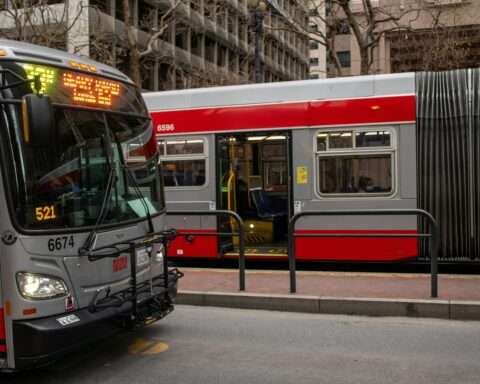The Atlanta Regional Commission has approved a transportation plan that outlines how it will allocate $168 billion in major investments for roads, highways, public transit and pedestrian and biking accessibility through 2050.
The Metropolitan Transportation Plan calls for a mix of local, state and federal funding to cover projects throughout the 20 counties centered around the city of Atlanta. Currently, 6.2 million people live in the metropolitan area, according to the U.S. Census. The area is expected to add 1.8 million residents by 2050.
The commission worked closely with local governments and the Georgia Department of Transportation to develop the plan, which also received more than 71,000 public comments from 2020 to 2023.
The plan is “a bold blueprint that will keep our region moving forward in the decades to come,” said Atlanta Mayor Andre Dickens, who also serves as the commission’s board chair. “These investments will help improve quality of life and ensure that our economy remains strong,” Dickens said in a press release.

The majority of funding, about $105 billion, is dedicated to maintaining transportation infrastructure — mainly freeways, bridges, roads, bus fleets, heavy rail and streetcars. More than $13 billion will fund adding express lanes on Interstate 285 and interchange construction in Dekalb, Fulton, Gwinette and Rockdale counties. Another $18 billion will support city, county and state agency staffing and operations.
Public transit will also receive a $10 billion boost to add more rapid bus service and light rail streetcar routes. Another $8 billion will widen and extend existing roads. Safe pathways for pedestrian and bicycles will also receive nearly $4 billion under the plan. Another $5.8 billion will flow to programs that encourage alternatives to driving such as taking public transit, carpooling, walking, biking or working from home.
Every year, about 600 people die and 3,000 are injured in vehicle crashes throughout the Atlanta region, officials said. Safety enhancements will be part of the designs for new sections of highways, roads, and bicycle and pedestrian paths.
The plan does not include any specific investment for electric vehicle charging, but the Atlanta Regional Commission is expected to release a Regional Transportation Electrification Plan this year to make it easier for residents to buy and use EVs.
As a major industrial hub in the Southeast, Atlanta will also see an increase in freight traffic in the coming decades. Freight shipping traffic on trucks, trains and planes is expected to increase 70% by 2050, according to the transportation plan executive summary. The regional commission is also working on an update to the Atlanta Regional Freight Mobility Plan due by the end of the year.
The largest source of funding are city and county governments contributing $73.8 billion. The state of Georgia is contributing $52.6 billion. Another $43.7 billion will come from the federal government.
“Metro Atlanta’s continued prosperity is not a given. We must keep investing in our infrastructure and in our people to build a successful future,” Atlanta Regional Commission Executive Director and CEO Anna Roach said in a press release.
Although it defines the key areas for investment, the plan is still an outline subject to shifting needs within the community.
The plan also needs federal approval before the projects can move forward. Once the Atlanta Regional Commission submits the details, the U.S. Department of Transportation has 30 days to determine if it meets all federal metropolitan planning requirements before giving the green light for implementation to begin.
All news and information on this site is provided by the team at Strategic Partnerships, Inc. Check out this short 1-minute video that provides a quick overview of how we work with clients.












